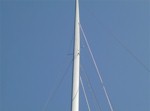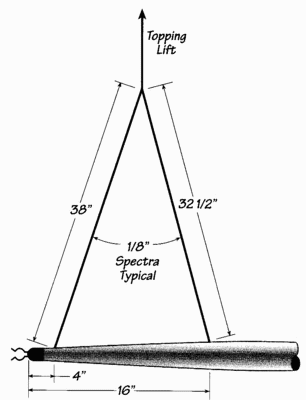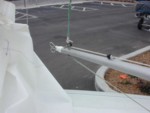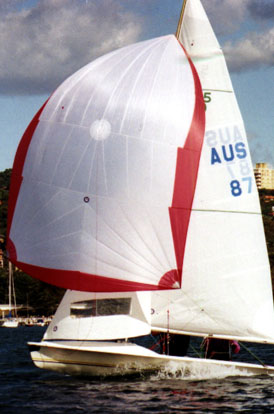BIGGER and STIFFER - Size DOES Matter
The Longer Luff Spinnaker UpdateBy Jesse Falsone
Six months have elapsed since I last reported on Long Luff Spinnaker developments ("Does Size Really Matter", Tank Talk, Spring, 2002). Within that time I've personally logged over 30 days of sailing, most of them windy, with various new spinnaker designs. It's funny because the "big spinnaker" doesn't seem that big anymore. Experience breeds familiarity I suppose, but the speeds, now greater than before, seem normal, and the forces seem not so extreme. It's just regular 505 sailing again, but a heck of a lot more fun.
To be sure, figuring out the new kite does take some time, so if you've been wasting precious windy afternoons mowing your lawn, you'll be taking some transoms come the fall regattas. Fret not, however, because I'm going to clue you happy homeowners into a few of the idiosyncrasies of LLS and its accompanying rigging. You can buy me a beer at the next regatta!
Like most experienced crews, I'm biased and opinionated, and I think that my way is the right way. So, I'm going to give you my take on what's fast. I spent a lot of time chasing second opinions in the previous article, and besides, nobody wanted to give me any data this time around! I was surprised at all the unreturned email and phone calls from various rock stars around the word (yeah, you know who you are). There are never any secrets in the 505 class until you start asking the right questions I guess. Need I digress.
Jesse Falsone and Macy Nelson working the big spinnaker in 18-20 knots on the West River in Galesville, Maryland
A STIFFER RIG
Macy and I use a Proctor Cumulus section with a near-maximum spinnaker halyard height and I like it. Our theory for choosing the Cumulus was that we wanted a rig that could better handle the greater forces and accelerations that we would see at the 2002 Worlds in Australia. Is it faster than the D? No, not really as far as we can see unless you count a broken stick as being slow. My point is that the Cumulus just doesn't distort as much as the D going downwind, so the peace of mind that I get when I look up and see a reasonably shaped spar is worth it. In contrast, I've seen some unsupported D's that look downright ugly on a windy spinnaker reach with either a large amount of side bend and/or inversion. I can only think that it's only a matter of time before catastrophic failures occur sailing in heavy wind and waves. This may be all in my head, but we'll see what happens in Australia. Five of the top 10 teams at this year's North American's now use a Cumulus, including the winners. The Cumulus is quickly becoming the predominant mast in Europe as reported in a recent issue of Yachts and Yachting Magazine.
You don't need to go running to your local spar dealer if you sail in light and moderate winds with a D. However, if you plan on competing with a D in heavy air, I think it's prudent to stiffen up your rig. I outlined the current systems for stiffening the D in my first article. A few boats at the North American's this year used these systems to good effect. I have heard that some boats in Northern California were seeing some cracks developing in their spars despite the added stiffening, but they may have retrofitted older rigs.
We have not tried any additional stiffening with the Cumulus-like trap line twings or double spreaders because we don't think it's necessary. However, I'm not ruling anything out just yet! Lots of top sailors in the UK and Europe are using trap twings with all section types - even the Superspar M2. As previously reported, some Aussies are big on double spreaders.
Hamlin and Martin are using trapeze line twings on their Cumulus, but not for downwind sailing. They have actually installed the twing about 18 inches down from the hounds and shortened their spreaders to promote additional side bend for heavy air upwind sailing. It may be that they prefer more side bend to de-power when the breeze is on.
PRE-BEND - IT'S NOT JUST FOR LIGHT AIR ANYMORE
We have been very aggressive with our use of the pre-bender downwind, and I think this is an important adjustment for the LLS. I have found that substantial pre-bend on the downwind legs is critical to preserving a nice curve in the mast all the way from top to bottom. I've actually modified my pre-bender to allow for additional travel, and we can now pre-bend to approximately 2" above the zero setting on the standard Ullman tuning grid. Additional pre-bend does a few things downwind:
it really keeps the mast from inverting due to excessive pole compression;
when the mast is pre-bent down low and there is ample tension on the shrouds, the top of the mast is far less likely to take on extreme forward bend;
pre-bend keeps the mainsail shape smooth, a bit flatter, and the leech open;
pre-bend helps keep the pole off the headstay.
I'm a big believer in pre-bend downwind now. OK, Mike and Howie still don't use one perhaps because they prefer using a very short ram track that doesn't extend above the boom band, but I don't see the downside to having it. You might want to add about a 6:1 or 8:1 purchase because it can be tough to raise downwind with the pole launched. The pin system is not very effective for this application because you really need to go to maximum pre-bend to get the desired effect. Our ram car is located 1-inch above the boom band at maximum pre-bend.
In conjunction with pre-bend, I recommend you use plenty of shroud tension while heavy air reaching. Like running backstays on a big boat, shroud tension helps keep the middle of the mast from inverting by inducing more bend.
TOPPING LIFT SOLUTIONS
I've tried a number of different topping lift rigging ideas to keep the pole at the correct height both when launched and stowed. I prefer to have my pole a few inches lower than most people because the 6-meter spinnaker flies a bit lower than the old one. My original jury-rig of simply attaching a piece of shock cord to the pole and the other end to the topping lift a few feet up worked, but was not very elegant. When the pole was stowed, the shock cord pulled the pole up and created a bunch of slack in the topping lift that would then get caught in the pole forks or around the pole. I then tried rigging an internal topping lift system that I though was real slick. I installed a 16mm Harken Thru-Deck block on the outboard end of the pole where the upper eyestrap is normally installed. I ran the topping lift through this block and inside the pole. I attached a stopper at the correct location, and attached a piece of shock cord with one end on the topping lift and the other tied to the bitter end of the pole launcher line which resides inside the pole too. The goal was to keep it clean and not disrupt the operation of my pole retractor shock cord that slides along the pole as it's launched. This rigging idea certainly represented an improvement, but it too created a problem. Since the topping lift now ran internally, the pole was more apt to rotate on its longitudinal axis (twist). This problem manifested itself in the pole launcher line occasionally jumping the Spiro sheave. I therefore had to compromise by running the topping lift externally along the pole to a length of shock cord like Ethan's system pictured in the first article. With my system, I rigged the block high enough so that the pole retractor shock cord would not interfere. To prevent the pole from twisting I taped the shackles to the block on top of the pole. This essentially immobilizes the block and works quite nicely.Barney Harris developed a nice system that uses a split topping lift. The longer forward line takes up the tension when the pole is launched while the aft line takes up the tension when the pole is stowed. If you like using a pole retractor shock cord, you will have to modify it to be fixed because it won't be able to slide along the pole. Check out the diagram.
FORK THE POLE
Ultimately, it would be nice if we had a slightly longer pole with this new spinnaker, but that probably won't happen because it hasn't been a big issue. I have found that when it's windy or in dead downwind sailing mode, the LLS flies a bit further out in front of the boat than the old spinnaker. Instead of the guy compressing into the forks, it can sometimes pull out when re-launching the pole or simply blow out in a puff. This is a real pain in the ass, and certainly isn't fast. A longer pole would prevent this from happening. I have found that in moderate air sailing DDW, you need to keep a bit more compression on the spinnaker sheet to hold it in the forks when the pole is aft, or when the boat rolls to weather.
When it's windy, it's a good idea to tighten up your forks. Mike Martin says you can do this on the water by bending the forks in against the mast, then shove your 5/16" jib sheet (yes, jib sheet) into the forks, and rip out again. The act of rapidly pulling them out opens up the forks just enough so that a 3/16" spinnaker sheet tail will fit snug. Note that this only works for these size sheets.
In my quest to make a better pole fork, I fabricated my own that use larger diameter stainless rod and a slightly longer body. I've found that the larger rod doesn't bend open as easily and the guy stays in the forks a bit better as long as the spacing is correct. My rod bends back 180 degrees so that there are is nothing for the jib sheets to hook on and no sharp ends to poke through a sail. The longer body provides a better angle for the guy to slide back along the pole allowing for the pole to shoot for-ward when launching instead of coming aft (which is very annoying and slow). I also used some high-quality black Delrin. Black Delrin is better than white because it is opaque and much more resistant to UV degradation.
You might also want to consider using a pole with a Fico fitting on the end. This fitting has jaws that hold the sheet in the pole. You don't need to open the jaws when inserting the guy, but you need to open them for removal, and that slows your jibe down a bit. It's a nice fitting for the 505 if you want a captive end, but it is a bit heavy and long (you will have to cut your pole down to make it legal - 99 inches total length).
FOREGUY
I prefer the foreguy a bit further forward to stop the pole from bouncing. Note here that my pole is lowered about 6 inches from the old standard when launched. Relocating the foreguy exit helps eliminate bounce by preserving the original geometry. The downside is that the foreguy will be effectively shorter on one side because it has to bend around the ram strut. This doesn't seem to be a major problem as long as you have some low stretch sheets and you don't mind the guy being a little bit off the headstay on one jibe.
Some people have rigged an adjustable foreguy to regulate pole height-tighter for a lower pole and looser for a higher one. The advantage to an adjustable foreguy is it lets you regulate the luff tension which can be effective for promoting a more asymmetrical spinnaker shape. It's no secret that the fastest spinnaker shapes for apparent wind sailing are asymmetric (like on skiffs). Anything you can do to induce this more efficient shape the faster you will be. Since I don't use an adjustable topping lift, I rigged a simple foreguy tensioner to the existing topping lift cleat on the centerboard cap. It's extremely easy to rig with a small piece of line and a floating block that floats on the foreguy between the mast step and the foredeck.
LLS DESIGN
How big can you go with the LLS is certainly the question everyone is trying to answer, albeit secretly for now. According to Ethan Bixby, the theoretical maximum dimension is about 241 ft2 , but I don't think anyone is having much success with kites that big because they start interfering with the other sails, and can't reach very well. Most of the monster kites seem to be settling in around the 210 ft2, but with different foot and midgirth dimensions. I don't know what designs will ultimately prove to be the fastest yet. My hunch is that the fastest spinnakers will be over 200 ft2 and will prove to be quick in wire running conditions up to when it starts really nuking and control starts to be a major factor say 23 knots. I'm assuming this for a Worlds course where there are two runs, with the first run on the second leg, and the reaches are 90 degrees eliminating the need for a tight reaching design. I also think that the smaller LLS, say around 175 square feet, will be best for lighter air when we're going DDW and flying shape becomes important, or if the race committee decides to tighten up the reaches to keep us on the wire. It's all speculation right now backed by limited data and testing, so take it with a grain of salt. The top 2 boats at this year's ECCs were using big kites - one North and one Ullman. The fastest boats at the North American's were also using relatively large spinnakers. The current Ullman design (the one Howie and Mike used) is much larger on the foot than the current large North Design - 4.4 vs. 4.0 meters. However, the Ullman is much more triangular and has less area higher up in the sail than the North. I think the overall size differences are negligible. The big Pinnell & Bax design is similar to the North in basic dimensions. Other sailmakers in Australia seem to also be going towards designs with more parallel leeches up through the midgirth.
What about shape and cut you ask? I'm a proponent of relatively full spinnakers that are powerful and forgiving. I prefer to look around on the wire and not limit my focus to spinnaker trim, and that is why I detest overly flat shapes that collapse the second you take your eye off them. I also got tired of our crosscut heads getting all distorted at the seams halfway into the season. The crosscut, or horizontal seams, allow the spinnaker to take on a somewhat asymmetric shape on the reaches and provide more stability. Ethan wanted to preserve this feature while also prolonging the competitive life of the sail. He has developed a nice design that achieves these goals by incorporating a radial head design.
The first meter or so has radial panels (vertical seams), a crosscut middle, and radial clews. An additional benefit is that the radial head seems to reduce the awful "elephant's ass" (long, vertical crease) that crosscut sails are prone to. Some designers abroad have gone to a full tri-radial. There were a number of Canadian Quantum triradial spinnakers in Kingston, and they proved to be fast in light air.
SHOULD YOU RE-CUT?
I think it's been proven that re-cutting a good 5-meter spinnaker is not a bad option. Our tests seem to indicate that a re-cut 5meter medium spinnaker provides enough area to be competitive. This spinnaker is probably up around the 190 square foot range and has never been slow against the new North AP designs. The re-cut North and Ullman chickens also seem to go well in light air when flying shape is more important than sheer size. So, if you have a recent 5m luff medium or chicken that's in good shape, I would advocate doing the conversion if you're on a tight budget, or if you want a reasonable practice sail.
INTANGIBLES
I prefer a deeper rudder with the LLS as a safety against loosing grip on those windy reaches. The new high-aspect rudders are about 5 inches longer than the standard rudders of old, and they definitely give you a higher degree of confidence when the boat is healed over. I'm finding it's beneficial to keep my weight further back on tighter windy reaches. This technique pushes the transom a bit deeper and prevents air from getting under the hull and ventilating the rudder. I also think having a flattening reef is a must to keep the boom out of the water on the reaches. If you don't have one-get one!
THE VERDICT (THUS FAR)
Top competitors want to be bigger and stiffer, but we're not sure just how big and stiff we can be and still be a stud on the water. There's less emphasis on the high road now with the new course, so going to a spinnaker that is less of a compromise between a runner and a reacher is good logic. My recommendation for those of you wanting to buy only one chute is to recut a good 5-meter chicken chute for light air conditions, and buy a new, larger kite for that 10-22 knot range where your looking for power.
Finally, none of this advice will make much of a difference unless you apply it. Get out there and go sailing!
Another Solution for the D - From the mind of Team SPOT
We loathed the idea of hanging more spreaders and shrouds on the 505 mast. More windage, more weight aloft, and additional tuning complexity to a system that we had invested 5 years developing. So, we started last fall with an old mast and attached four spinnaker halyard hoist points spaced at six-inch intervals below max height.
During practice sessions that commenced in Florida in January, we sailed with the spinnaker hoisted to heights at and below the maximum allowable by class rules. We reviewed feedback from fellow 505ers who sailed in the Australian Nationals and observed Macy and Jesse who switched from the Proctor D to a Cumulus mast section. We also watched the rig-our initial guess was that we would have global stability issues-spreader attachments failing allowing the mast to invert and fail catastrophically. This never happened no matter how much wind we sailed in.
We watched the main sail shape - and noted that the vast majority of the effect on the main was due to the flexure of the tip and not the middle of the mast itself. Middle mast flex could be reduced with ram and shroud tension, but there was no way to reduce the tip flex.
Finally, we did some analysis and found that by lowering the hoist point 12.4cm on the D we would have the same material stress as the Cumulus. By lowering 5cm we would get the same deflection above the hounds as a Cumulus. Our testing had shown that lowering the halyard height more than 20cm was noticeably detrimental to the spinnaker and our performance. We selected our halyard height to be around 15cm below the maximum allowable.
We then installed a lift to bring the halyard up to max height for light to moderate wind sailing. This consists of 7/64ths Spectra and a small block lead to a cleat on the centerboard trunk. Class rules state that the halyard must be pulled at right angles to the mast for measurement, so we located the halyard lift fittings just above the maximum legal limit so that the halyard is dead on when hoisted.
In operation we will sail with the halyard at maximum height in any breeze up to 18 or so knots. Above this we will simply release the lift and allow it to function from the lower hoist height. Our D mast is less stressed and less flexed than the Cumulus masts others use, and we have not had to add extra spreaders or shrouds. Our upwind set up remains unchanged.







